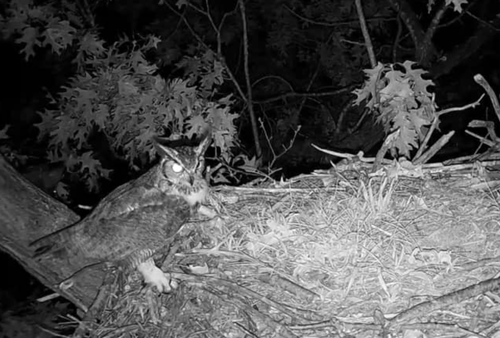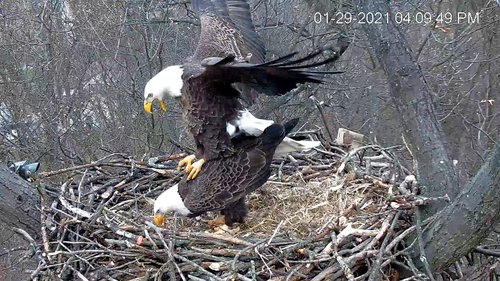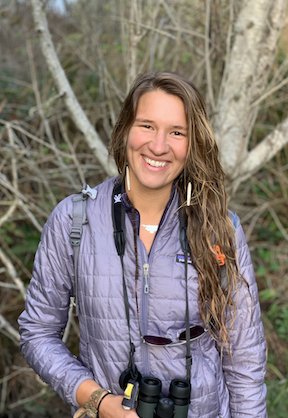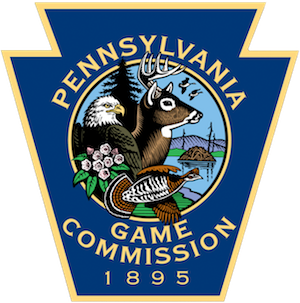Hanover Bald Eagle Blog # 3 - 2022
In partnership with Pennsylvania Game Commission and Comcast Business .
It looks like the local great horned owls haven’t given up on the Hanover nest yet. We found a clip of the eagles in an agitated state around midnight on Tuesday of January 18th, during which they both vocalized and stood watch over the nest for half an hour, posturing and making their voices heard far and wide. If you listen closely to this clip, you can hear the hoot of a great horned owl in the background. Based on what we learned from last week's blog, can you distinguish between the female and male great horned owl hoot?
On January 19th, again around midnight, one of the owls briefly touched down at the nest but left when the eagles returned. Neither raptor species wants to relinquish their claim, but the eagles are defending their territory with vigor and signaling to the owls that they are still invested in their home. Chances are, they will prevail!

^Click to view the full highlight!
This week we witnessed a clear sign that the Hanover eagles are preparing for parenthood — on both Tuesday and Thursday of this week, they copulated! Their first attempt occurred in the nest; then, in the sentinel tree next to the nest. These copulations are slightly early compared to our records for the last few years
In 2019 the pair was seen copulating on February 26th; in 2020 on February 4th, and in 2021 on January 29th. Clearly, the eagles dance to the beat of their own drum, listening to rhythms buried deep in their bones.

A mating attempt from last year, January 23, 2021.
Eagles, like other birds, initiate breeding behaviors in response to environmental and internal cues. Right now, the days are becoming longer, and this shift in daylength provides a significant environmental cue for birds. First, they perceive the change through their eyes; then, that information is then transferred to the hypothalamus (part of the brain), which triggers the release of reproductive hormones. This chain of events results in physiological developments, like ovary growth, and also behavioral changes, like the impulse to copulate.
When birds copulate, they engage in what is called a “cloacal kiss,” which facilitates the transfer of sperm. The cloaca is a body part unique to birds, amphibians, reptiles, some fishes, and monotremes (an ancient order of mammals). The kiss requires a balancing act, whereupon the male gently perches on the female’s back, curling his talons so as not to hurt her. Both birds work to align their cloaca, and as we saw this week, the meeting is quite brief.
Once the sperm enters the female’s body, it remains stored for a species-specific length of time. Chickens store sperm for up to 30 days, pigeons for up to six days, and black-browned albatrosses, who maintain long-distance relationships while the male traverses the sea, can store sperm for up to two months! Bald eagle females are believed to store sperm for up to 10 days.
Once the pair is successful, meaning fertilization occurs, we can expect the female to lay the first egg 5-10 days later. During this phase of the breeding season, pairs may copulate several times a day, even though it may be some time before fertilization takes place.
Stay tuned next week for a look at Bald Eagle “sky dances,” once of the most prized sights in wildlife viewing and one of the most difficult to witness!
Remember! Comment on this blog below for the chance for your question to be answered!
Sources
Birkhead, Tim. (2017). The Most Perfect Thing. London. Bloomsbury Publishing PLC.
Gerrard, Jon M. and Bortolotti, Gary R. (1988). The Bald Eagle, Haunts and Habits of a Wilderness Monarch. Smithsonian Institution.

RETURN TO HANOVER BALD EAGLE BLOGS
WATCH THE HANOVER BALD EAGLE LIVE CAMS
For over 20 years, HDOnTap has provided live streaming solutions to resorts, amusement parks, wildlife refuges and more. In addition to maintaining a network of over 400 live webcams, HDOnTap specializes in design and installation of remote, off-grid and otherwise challenging live streaming solutions. Contact press@hdontap.com for all media needs, including images and recordings.

